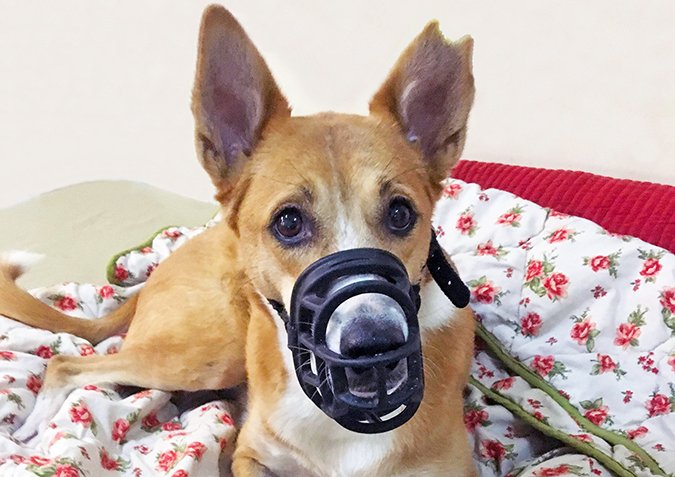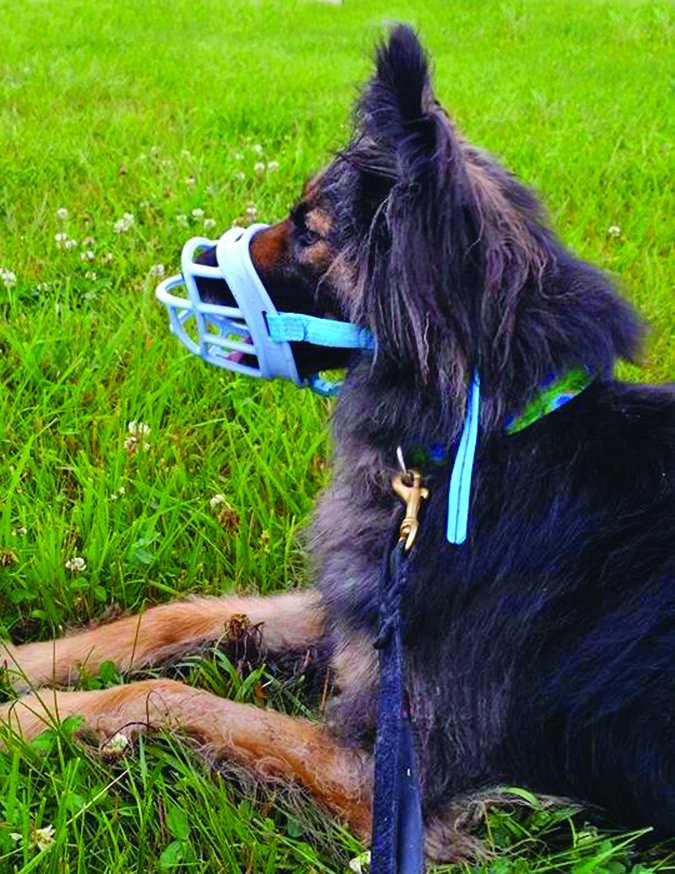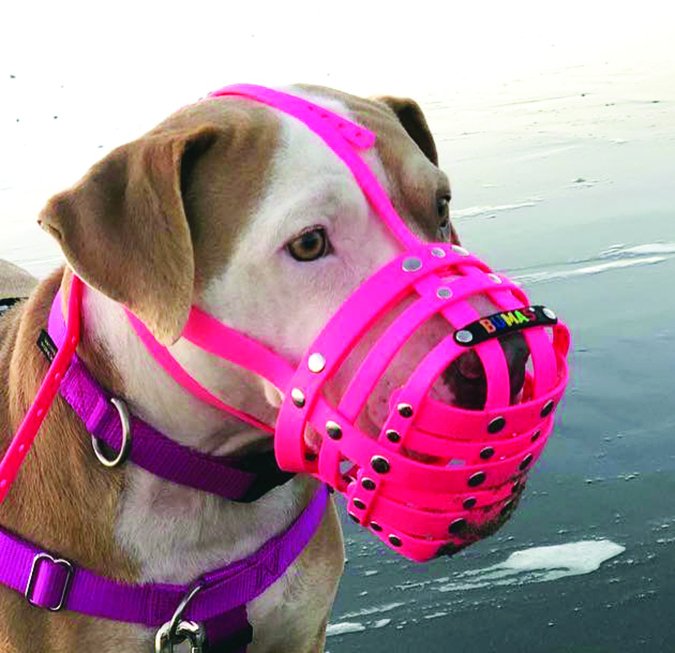A significant percentage of my clients come to see me because they have dogs with aggressive behaviors. Often, they will ask me if their dogs should wear a muzzle. My answer is almost always, “Good idea!” In each case, however, we have a serious discussion about the reason why the client’s wants to use a muzzle, when and how the dog’s aggressive behavior presents, and – this is the clincher – whether the client is willing and able to take the time to condition her dog to love the muzzle before starting to use it.
Why and When to Use A Dog Muzzle
The “why” seems obvious: You use a muzzle to prevent your dog from biting someone – human or other animal. Duh! But there are a few certain circumstances where it is appropriate to use a muzzle and many others where it is definitely not.
Let’s start with the situations when it is definitely not appropriate to muzzle your dog.
How NOT to Use A Muzzle on Your Dog
It is not ever appropriate to muzzle your dog so you can put her over-threshold in an avoidable situation. Here are some examples:
- “Oh gee, the grandkids are coming over and Muffy might bite them. Let’s muzzle her so the kids can have fun with her and she can’t bite them.” NO! Instead, either use scrupulous management to keep her and the kids safe from each other while the young’uns are visiting, send her to a friend’s house for the day, or perhaps board her for a longer grandkid-visit.
- “My friend wants to take her dog to the dog park, and she wants us to come with her, but Rocky, who loves my friend’s dog, might bite the other dogs at the park. Let’s muzzle him and take him along.” NO! Rocky doesn’t get to go to the dog park. Ever.
- “Chomper guards his food bowl. Let’s muzzle him and show him we can take his bowl away from him because he needs to learn that humans are the boss.” NO, NOT EVER!

When It IS A Good Time to Use the Muzzle
Here are some appropriate times when a muzzle could or should be used:
Emergencies. Any animal in pain may bite. If your dog is injured and must be moved or handled it is strongly advised to muzzle her. This, of course, will be easier and less stressful for everyone during an already stressful event if you have taken the time to convince her that a muzzle is wonderful.
Procedures. When your dog must be handled or examined by your veterinarian for an unexpected condition, or treated at home for an injury, and there’s a good likelihood she will bite during the procedure, she will need to be muzzled for everyone’s safety.
Muzzles should be used as needed for emergency or unavoidable procedures. If your dog needs to be muzzled for routine care or grooming, you have some counter-conditioning work to do to help her learn to love (or at least happily tolerate) these events!
Note: While veterinarians often use “sleeve” muzzles, these are not recommended, as they inhibit your dog’s ability to pant and take treats, and they can be very stressful for dogs. Most veterinarians will allow you to use your own good-quality muzzle.
Public safety. A muzzle is an appropriate tool if you know that your dog might try to bite a toddler who rushes up to hug her, a well-meaning dog person who insists that “all dogs love me,” or an off-leash dog who bounces up to say hi.
Even if your dog is on a leash, you will still be responsible (and she will be in big trouble) if she bites someone who invades her space. Muzzling her when you take her out in public keeps everyone safe (and her out of trouble!). It also tends to keep people away, as they assume (often correctly) that a dog who must wear a muzzle would prefer not to be social.
Of course, you will need to fiercely protect her to prevent people and other dogs from interacting with her, even if she is muzzled; the muzzle itself is just a backup.
In a behavior modification program. A muzzle can be a useful tool in situations where, based on all the behavior-modification work you’ve been doing, you’re 99.9 percent sure it’s going to go okay, but you’d like a little extra insurance.
Say you’ve been working with dog-aggression issues between your own canine family members, or you’ve done a ton of counter-conditioning with your dog’s dog-reactive behavior, and you think you’re ready to let her interact with other dogs. Perhaps she’s been fearfully aggressive with your grandchild in the past and you’ve worked your tail off using the CAT procedure (Constructional Aggression Treatment) to convince her that she loves the toddler, and you think it’s time to let them meet.
This is the ideal time and place for your dog to wear her well-loved muzzle. Not only does it prevent that tiny 0.1 percent chance of a tragic “Oops,” but it also helps you relax, so that your stress about that first interaction doesn’t add to your dog’s level of stress. (Remember, stress causes aggression!)
10 Tips for Teaching Your Dog to Love a Muzzle
All of the “could or should” situations are predicated on the assumption that you have taken the time to teach your dog to love her muzzle. You will use classical conditioning – giving your dog a wonderful, happy association with her muzzle, to make any muzzling experiences as positive as possible. Here’s how:
1. Purchase a top-quality basket muzzle.
(See the muzzles we love most below). Good basket muzzles allow your dog to breathe, pant, eat, and drink, which reduces muzzle-related stress and prevents overheating.
Measure your dog to ensure a perfect fit; most muzzle websites include a sizing chart that will help you take proper measurements and order the proper size. The best sites will custom-fit your dog’s muzzle. For additional information about how to find the right muzzle for your dog, see the MuzzleUp Project.
2. Show your dog the muzzle.
Don’t even try to put it on yet! Just hold it up, then feed your dog a yummy treat from the other hand. Hide your treat hand and muzzle behind your back, then show it to her again, and feed.
Repeat this step until, when you bring the muzzle out from behind your back, her eyes light up and she looks for the treat. She now thinks muzzle = yummy stuff!
3. Feed treats in the muzzle.
You can push high-value treats through the front of the muzzle or use squeeze cheese through the straps; the important part here is that your dog puts her nose into the muzzle voluntarily, you do not push the muzzle onto her nose. If she backs away, don’t follow her with the muzzle, wait for her to come back to you.
4. Increase the duration.
When your dog voluntarily offers to put her nose into the muzzle (ideally shoves her nose into the muzzle), gradually increase duration by feeding, pausing, then feeding again several times while she keeps her nose in the muzzle.
5. Play with the straps.
Now, while holding the muzzle with one hand and occasionally feeding treats, play with the straps a little behind your dog’s head as if you are getting ready to buckle it.
6. Condition your dog to the sound of the snap.
If your muzzle has a snap rather than a buckle, and your dog might startle at the sound of the snap, take time to condition her to the sound separately from putting the muzzle on. Hold it up so she can see it, snap the snap in place, and feed her a treat – until the sound of the snap makes her eyes light up and she looks for the treat.
7. Close the snap or buckle briefly.
This can be tricky. For starters, how do you keep feeding treats while using two hands to close the snap or buckle?
Perhaps you have a partner who can help by feeding the treats while you manipulate the hardware. If not, you can smear peanut butter or squeeze cheese on your refrigerator door or on a vinyl floor to keep your dog happily occupied while you snap or buckle.
Alternatively, try the Chase ‘n Chomp Sticky Bone, which can suction onto your floor, wall, or refrigerator door.
8. Leave the muzzle on for longer periods.
Gradually leave the muzzle on your dog for longer periods, making sure to keep her happy (feed treats!) while it’s on. Over time you can reduce the frequency of treats, but always be ready to treat occasionally to keep it happy for her.
9. Refresh the positive association.
Be sure to do “happy muzzle” sessions routinely, so she doesn’t only wear the muzzle for bad/scary times. Once you have conditioned her to love her muzzle, if she wears it only for trips to the vet’s office, her association will change from positive to negative and you’ll have to start all over again. A good rule of thumb: Give your dog at least 10 happy muzzle experiences for every stressful one.
10. Watch this video.
This Youtube video by superb trainer Chirag Patel (of Domesticated Manners in London, United Kingdom), is an excellent tutorial for teaching your dog to love a muzzle.
Okay now, time to get to work! Check out our favorite muzzles, measure your dog, order one, and start convincing her that it’s the best thing since sliced chicken!
Best Dog Muzzles
We asked our trainer network to tell us about their favorite muzzles. We expected to hear about a variety of different muzzles, but there was overwhelming consensus about just two brands. Here are the two, and some of our trainers’ comments about them:

The Baskerville Ultra Muzzle
The Baskerville Ultra Muzzle is widely known for security and comfort. The rubber material can actually be heated up and molded to better fit the shape of your dog’s face. Here’s what our trainers say:
Kelly Fahey, PMCT2, DogSmith of Hunterdon, Pittstown, NJ
“The Baskerville muzzle is my go-to muzzle. It allows your dog to pant, drink, and eat. There are other basket-style muzzles on the market, but they don’t seem to have a space to feed treats while working with your dog. I also like the extra strap that is on the Baskerville Muzzle. It attaches to the dog’s collar for a more secure fit.”
Jessica Miller, CPDT-KA, PMCT, CNWI, Go Pawsitive Dog Training, Clear Spring, MD
“The Baskerville saved us when our house flooded. My dog Handel had to be carried across a knee deep river, lifted into a truck by a firefighter (whom he tried to bite), walked through a flooded town surrounded by other stressed-out people and children, stationed at a church for an hour when we couldn’t get out, and then had to live at my mother’s house for three days before we could find a new place to live. I was able to feed him, he could drink, I knew he wouldn’t overheat, and I was sure it wouldn’t come off or fail. If we didn’t have his muzzle, almost all of that would have been impossible and I dread to think what could have happened. Plus, it was a nice light blue color that stood out against his dark fur, so that strangers could see he needed space.”
Cindy Mauro, CPDT-KA, Cindy Mauro Dog Training, Northern NJ
“I do a lot of work with dogs who need to be muzzled. My go-to is the Baskerville muzzle. The dog can easily eat treats, drink, pant, and bark with this muzzle on. With proper muzzle training, there is little fuss. ‘Good things happen with the muzzle on.’”
The Bumas Muzzle
The Bumas Muzzle is made to order. It can be customized with fewer or more straps (depending on your dog’s anatomy and the level of security needed), and you can specify the color of each strap on the muzzle. These muzzles are very expensive, however. If we had a dog who needed to wear the muzzle often, it could be worth the expense, but it’s not likely practical for a dog who only needed to wear a muzzle at the vet once or twice a year.
Cindy Mauro
“The Bumas muzzle is my top choice for flat-faced dogs. It comes in many custom colors, which makes it like wearing a nice pair of glasses. The colors tend to appear ‘friendlier’ on the dog.”
Laura Dorfman CPDT-KA, PMCT1, Kona’s Touch, Chicago, IL
“The Bumas offers a good custom fit for lots of differently shaped dog faces, and I like the colors too.”
Author Pat Miller, CBCC-KA, CPDT‑KA, is Whole Dog Journal‘s Training Editor. She lives in Fairplay, Maryland, site of her Peaceable Paws training center. Miller’s newest book is Beware of the Dog: Positive Solutions for Aggressive Behavior in Dogs.






My male mini Schnauzer almost 3, barks at anything that moves. How can I deal with this? It is getting very annoying . He is persistent and will not let up.
Our 8 yr old rescue Border Collie has a constant reactionary habit to return barking back at the barking of the dog next door who barks about about 6 times whenever he is let out 24 /7. Our dog barks back about 66 times in reply , so horribly loud and jumps in the air to respond. We do not want to use a shock collar. Will a correct fitting muzzle begin to correct this disruptive habit? Concerned that WE will get arrested for” disturbing the peace.”
A muzzle will not restrict your dog from barking. A discussion with your vet on finding a proper trainer who specializes in positive behavior modification may be your best bet to solve this problem. A shock collar or any other negative or painful “cure” will only serve to increase your dogs’ anxiety and therefore will escalate undesirable behavior. Good luck with your pup.
Used a anti-barking collar for a bout a month. My beagle stopped barking from then on. My little Jack Russell barks at dogs passing by the window. I close the blinds. No barking for now.
Try talking with the neighbor first before reporting his dog.
Question regarding your comment: Even if your dog is on a leash, you will still be responsible (and she will be in big trouble) if she bites someone who invades her space.
Does this apply to another off-leash dog getting bit? We take good care in keeping our dogs on heel during our walks, but have had instances where other non-responsible dog owners let their dogs run off-leash and say: “my dog is friendly”. One of our dogs can be reactive to some, but not all dogs.
My dog was sent to a trainer for 6 months for birding. She had to pinch his toes for some reason(?) But she also had to walk him at night because of his depression. I can barely clip his nails. It is a fight between his,”OH MY GOD’, and OK BIte ME and treats. I muzzle him. He is anxious because of that. When I go to the vet, I muzzle him. He bears his teeth when they try to do anything. He is a well trained, easy-going Chesapeake Bay Retreiver that benefits from a lot of exercise and attention. So I am aware of his anxiety and muzzle him. His muzzle does have his name and a heart on it.
If a “trainer” pinched your dog’s toes (how ignorant), no wonder he doesn’t like his feet being handled.
My dogs love to eat bunny and deer poop outside in the yard, resulting in giardia and parasites. Several years ago Eden swallowed a peach pit that got lodged in her intestines and required surgery. If I can’t keep them occupied or if my daily walk is littered with peach pits, I will muzzle. Breaks my heart. Bought a high quality leather and metal basket type muzzle and keep the girls safe.
This was a wonderful training article. I have been training dogs for years
and thoroughly enjoy it. I started many years ago when all the “training”
was punishment. Then so many things came out, (Ian Dunbar, SATS -Syn
Alia Series on Animal Training, Clicker Cookbook by Shirley Chong,
Barbara Cecil and Gerianne Darnell, Jane Simmons-Moake, Decoding your dog
by American College of Veterinary Behaviorists, The Intelligence of Dogs by
Stanley Coren, Denise Fenzi “Train Your Dog to Listen Anytime, Anywhere, Fred
Brattain on Agility, and on and on. All this information was extremely useful
in training your dog.
Currently, my problem is my own health. After having two cataract surgeries one
for the left eye and one for the right eye, I was gradually getting back to thinking
about dog training when I fell in the garage and banged my head on the concrete floor.
After my veterinarian called me to find out why I hadn’t made it in to the clinic
to have one of my dogs and one of my cats attended to, and I explained that I had fallen
but I’d bring in my pets on Monday (instead of the Sat. appointment) I was thoroughly
scolded for not getting myself to the emergency room at the hospital. And then after I
hung up, the vet had one of his people call me back and convince me to get
medical help at the emergency room at the hospital. So I called a friend and she came
and took me to the emergency room. After several hours of tests, it was found that I
had sustained a concussion. After a couple of weeks with help for the concussion, I am
attending PT so I can get around with/without a cane and I can drive my car to obtain
food, etc. I’m extremely grateful to the vet for pressing me to get the help I needed.
So now I am continuing to think about working with my two little dogs (papillion and sheltie) so they can get back to learning agility. I have been training for NADAC and the pap
has earned his novice regular title, the sheltie has been training, but has not yet earned an
intro title. But I am starting to think about such things and am planning to work/play
with my babies as my health improves. Thinking about work/play with my little canines
brings a smile to my face and joy to my heart!
Thanks to all the people who helped us learn how to work/play with our dogs and
who gave us and the dogs great joy in working together while sharing time learning
all the many things needed for obedience, tracking, agility, etc. I had thought of it
as merely a hobby, but now it has become far more than that!
Great article!
This is a great article!!